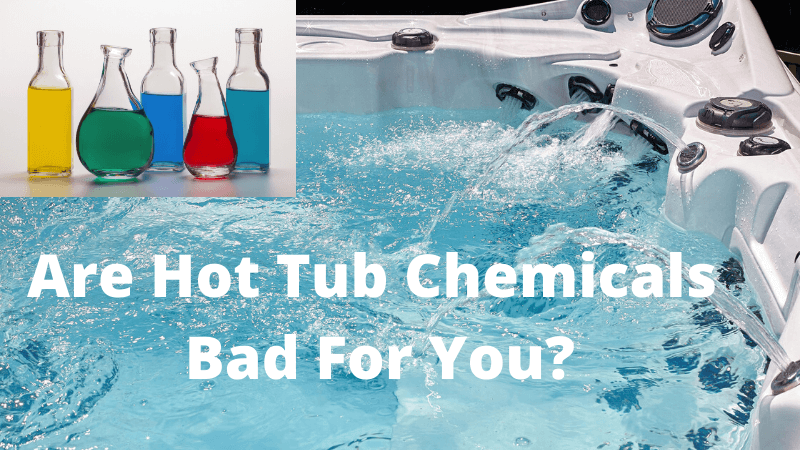
Many hot tubs rely heavily on chemicals to keep them sanitary and clean. They do a great job, but at what cost? Is it possible that the chemicals that you are using in your hot tub to keep you safe are actually really bad for you? Could you be actually damaging your health due to the chemicals that are in your hot tub?
Slightly worried by these questions I decided to do some detailed research and this is what I found out:
Are hot tub chemicals bad for you? Many hot tubs use chlorine or bromine both of which are powerful chemicals. They can cause skin and eye irritation as well as respiratory problems. Some studies suggest that they may be linked to immune system damage, fertility issues, liver, kidney and digestive tract problems and some cancers.
So, this looks like really bad news. However, read on and I will put some of this into context, look in more detail at the problems that both chlorine and bromine come with as well as exploring some much more natural alternatives.
First of all, why on earth are we putting these powerful chemicals into our hot tubs and then bathing in them?
Why use Chlorine or Bromine in a Hot Tub?
What would happen if you didn’t use any sanitizer at all in your hot tub? Well, for the first use or so it would probably be fine but, within a short period of time the water would become cloudy, foamy, smelly and very unpleasant.

Worse than this is the fact that this type of dirty water could also be harboring some really serious bacteria such as the Legionella bacteria which can cause serious illness or even death in some cases.
But why does the water become so dangerous so quickly?
Hot tub temperature – Firstly a hot tub is heated to fairly much the perfect temperature to encourage rapid growth of algae and bacteria. We like to have the hot tub a degree or two above our body temperature for it to have it’s soothing and warming effect but this also encourages rapid growth of bacteria.
Warm damp conditions – Coupled with the high temperatures the damp atmosphere of a hot tub is also a perfect breeding ground for bacteria. Most hot tubs will have their covers on for long periods of time in order to conserve heat. This is great from an energy saving point of view but means that the atmosphere inside the hot tub becomes very warm and very moist and very warm for long periods of time. This then provides the perfect breeding ground for bacteria.

High bather load – Compared to a swimming pool, for example, a hot tub has what is known as a “high bather load”. This means that there are a lot of bodies per cubic metre of water. Bear in mind that, no matter how clean we think our bodies are, they introduce all sorts of microscopic dirt and bacteria into the hot tub. The relatively small amount of water in a hot tub can then become quickly saturated with dirt leading to all sorts of issues.
So, as you can see it is a bit of an uphill battle to keep germs and bacteria at bay in a hot tub. The very high bather load, small amount of water, high temperatures and damp atmosphere means that, left unchecked bacteria will multiply at an alarming rate.
This happens far more quickly than in a swimming pool for example. A swimming pool is generally open to the air for most of the time, the temperature of the water is lower and there is a much greater quantity of water to soak up the dirt and debris introduced into the pool from our bodies.
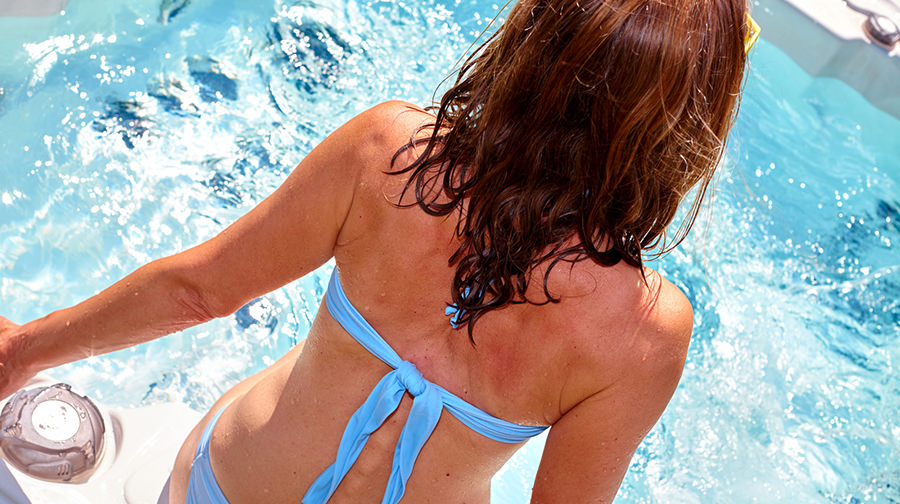
So, to prevent bacteria rapidly multiplying in a hot tub we need some mightly effective filtration system as well as an effective disinfectant. It’s worth noting that the Centre for Disease Control and Prevention only recommends the use of Chlorine or Bromine in public hot tubs. We will have a look at some alternatives in a little while but the official line is that, if you want to be sure that you have killed of all of the harmful bacteria in your hot tub then the correct use of either Chlorine or Bromine is the only option.
It has to be said that both of these chemicals do a fantastic job. They are great at tackling the dirt and bacteria and keeping us safe in our hot tubs. But are the very chemicals that we are relying on to keep us disease free actually harming us?
Using chlorine in your hot tub
Technically speaking Chlorine is a poisonous gas. It kills or bleaches everything that it comes into contact with. This makes it a relentlessly good sanitizer but also means that it is harsh, abrasive and potentially a health hazard for humans as well.

Chlorine and skin issues – Chlorine is well known for making your skin dry and itchy. It will bleach and destroy your bathing costume and make your hair dry and damaged.
The problem is that, when chlorine comes into contact with water it forms hypochlorous acid which basically strips the skin of it natural oils and moisture. Bear in mind that in the hot environment of a hot tub your pores are going to be open and you can see how damaging this can potentially be.
Nobody, in their right mind would bathe in a tub of acid!
In some cases, prolonged contact with chlorine can produce a rash, hives or burns. If you already have a skin condition contact with chlorine will almost inevitably make it worse as this post by the Colarado Springs Dermatology Clinic points out .
Chlorine and Respiratory Issues – We all know the familiar smell of Chlorine. As the Chlorine kills off bacteria it releases chloromines into the air and actually, the harder the chlorine is having to work, the smellier it gets. Personally I don’t mind the smell of chlorine too much as it has associations of cleanliness and happy childhood swimming session for me. But, for some people it is not only unpleasant but also an irritant as well.

In fact the United States Environmental Protection Agency describes chlorine as “a potent irritant the upper respiratory tract, and lungs. Chronic (long-term) exposure to chlorine gas in workers has resulted in respiratory effects, including eye and throat irritation and airflow obstruction.”
Remember, chlorine is a poisonous gas.
This document goes on to describe how breathing in Chlorine vapor acts as an irritant to the nose and throat resulting in a tickling and dry sensation even at very low concentrations. At higher concentrations, similar to those found in hot tubs the report describes how the mucus membranes become irritated.
However, it seems that there is little evidence to suggest, that at normal “safe” levels that Chlorine actually causes respiritary problems. It can bring on asthma-like symptoms for example,e but it doesn’t actually cause any illness. Of course, if you already suffer from a respiratory disease then the chances are that inhaling chlorine will make it significantly worse.
Does Chlorine Cause Cancer?
There is a lot of information, or some would say misinformation about this online. From my research, I haven’t found any sources that categorically confirm that chlorine causes cancer, but on the other hand, no one seems to be saying that it doesn’t cause cancer either. The Environmental Protection Agency statement about Chlorine linked above describes there being no information available as to the effects of inhaling Chlorine vapor and a link to cancer in humans.
So why all of the worry about Chlorine and Cancer?
Well, the study goes on to describe research that has been done into the possible carcinogenic effects of water that has chlorine in it. In this case, the testing was to do with the effect on the water of having chlorine in it and it’s possible link to cancer rather than the possible effects of chlorine itself causing cancer. These studies show an association between bladder and rectal cancer and chlorination byproducts in drinking water.
This all implies that inhaling Chlorine from your swimming pool is unlikely to give you cancer although there is a possible link to drinking water with chlorine in it to cancer in humans.
So why on earth are we still drinking water from our taps with chlorine in it? This is probably outside the scope of this post but I suspect it is a cheap way of keeping drinking water safe and it is considered that the risks outweigh the benefits. Remember also that the water filtration industry and the bottled water industry is massive – they have a lot to gain by openly discussing their concerns about the safety and quality of the water that comes into our homes.

Using bromine in your hot tub
Bromine is a dark unpleasant chemical named after the Greek word bromus which means “to stink”. Bromine has become popular as an alternative to Chlorine as, despite it’s name, if the water is balanced correctly, it smells much less than Chlorine and is supposed to be milder and easier to use.
However, if your water PH levels do go out then you will find that Bromine does have a very unpleasant smell and you will be reminded that it is actually a very close relative to Chlorine.
Is Bromine safer than Chlorine in a Hot Tub?
You will find that Bromine comes with a similar set of potential health hazards as Chlorine. It too can cause both skin irritation and breathing difficulties. Rashes from Bromine exposure are common and it can also cause red and irritated eyes as well.
Is there any link to Bromine and cancer? Well again it seems unclear. This document from Public Health England states that Bromine is not listed as a carcinogen. However, a number of sources including this post on livescience.com do state that in some cases Bromine can cause cancer.
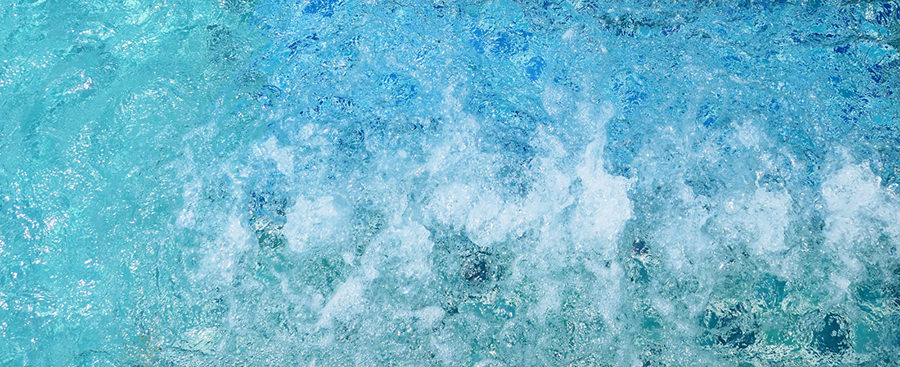
I think the point is that, with either Chlorine or Bromine, there are a number of serious concerns. I don’t think either is much better or worse than the other and seems from what I have been researching that both can cause skin and respiratory problems and there are some questions about both of them and their links to cancer.
Are you likely to get cancer from bathing in a hot tub a few times? Probably not. But think about the hot tub owner who has just invested in a new hot tub that will probably last for the next 10 or 15 years. With this type of investment you are probably going to make using the hot tub part of your daily life and keep it on all year round to get your money’s worth from your investment. So, we are talking about maybe three or more hot tub session per week for ten years. In total that’s 1560 hot tub sessions. Assuming they are 30 minutes each then that is a total of 780 hours – thats’ the equivalent of sitting in a hot tub continuously for nearly five whole weeks.
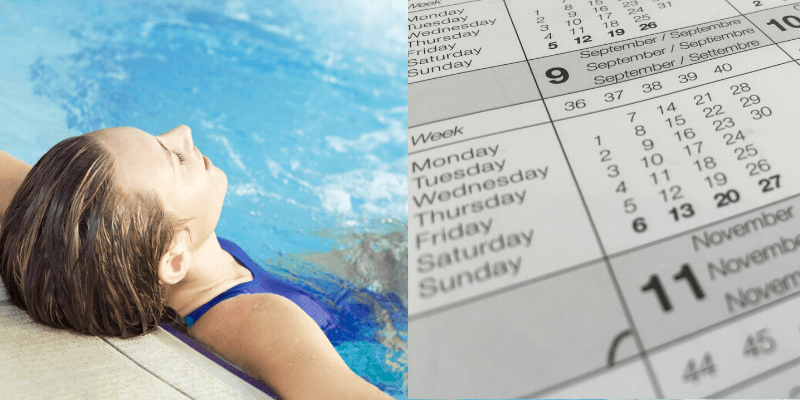
I’m not sure that, with that amount of exposure I feel completely happy with using either Chlorine or Bromine. In a hot tub your pores are open, your skin absorbs whatever is in the water, more than 90% of your body is completely submerged in a hot tub and you are constantly breathing in chemical vapors.
This is just my personal take on things but I really want to seriously look at ways of reducing or getting rid of my chlorine usage. Maybe in 15 years time research will show a definite link between these volatile chemicals and serious illnesses. By then, for me, it may be too late.
How to reduce the risks of chlorine and bromine in your hot tub
So, it looks as if it would be a sensible idea to limit our contact with Chlorine as much as possible. However, we must keep this in context. Without chlorine, the chances are that your hot tub would be an extremely unpleasant place with smelly, cloudy water teeming with possibly dangerous bacteria.
We have to weigh up the huge advantages to using Chlorine as a sanitizer with the possible drawbacks. Remember, as we saw above Chlorine or Bromine are the only way to guarantee that a hot tub is disease-free. They do a great job and the risks of not using them are far greater than the risks that they pose when in use.
Having said that though how can we minimize the impact on our bodies that Chlorine has whilst, at the same time, enjoying it’s excellent sanitizing properties?
Shock your hot tub after each use – If you shock your hot tub after each use it will allow enough time for the shock to do it’s work and kill all of the bacteria before decaying back down ready for your next soak. You should leave the lid off the hot tub after shocking it to allow the vapors to dissipate and also check that the chlorine levels have come back down to a safe level of between 3 and 5 parts per million before entering the hot tub.
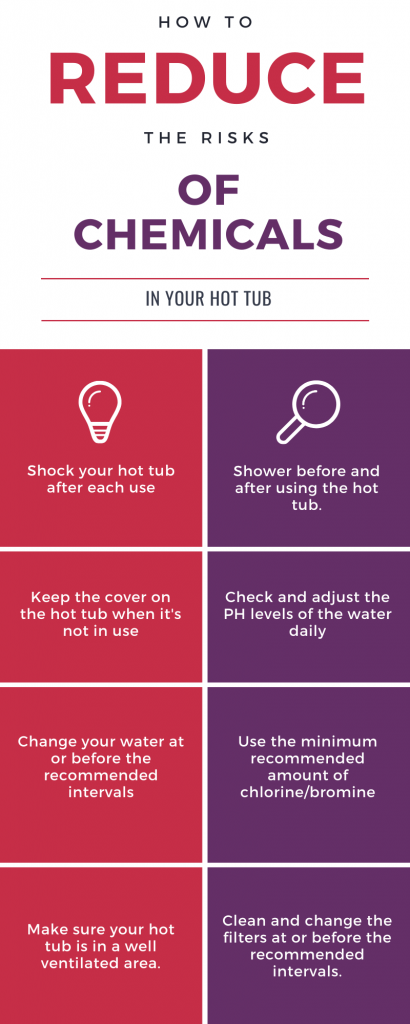
Shower before and after using the hot tub – The harder Chlorine has to work the more Chloromines it gives off so it makes sense to help things along a bit and try to prevent the hot tub form getting to dirty in the first place.
Showering before you go in the hot tub will remove many microscopic dirt particles and also makeup, shampoo, moisturizers etc all of which add to the bacteria load that Chlorine has to destroy.
It also makes sense to shower after using the hot tub as well to remove the Chlorine from your body. Moisturizing both your skin and hair can be a good idea as well to help recovery.
Keep the lid on your hot tub when not in use – Apart from immediately after shocking your hot tub try to keep the lid on it as much as possible. This will obviously help to conserve energy and will also prevent a lot of airborne dirt and debris from getting into the tub. Again the cleaner the water is kept the less work the Chlorine will have to do and the less you will need to use.
Check PH levels daily – Chlorine is at it’s most efficient when your PH levels are correct so check them and adjust daily. Again, the aim is to use as little Chlorine as possible to keep your hot tub clean, if your PH levels are out you will need to use more Chlorine to get the same cleaning effect.
Change your water at the recommended intervals – The cleaner your water is the less Chlorine you will need so it makes sense to do a complete water change at regular intervals. Usually, people change their water every three months or so but there’s no reason why you couldn’t do this more frequently if you really wanted to be sure that you were being as Chlorine efficient as possible.
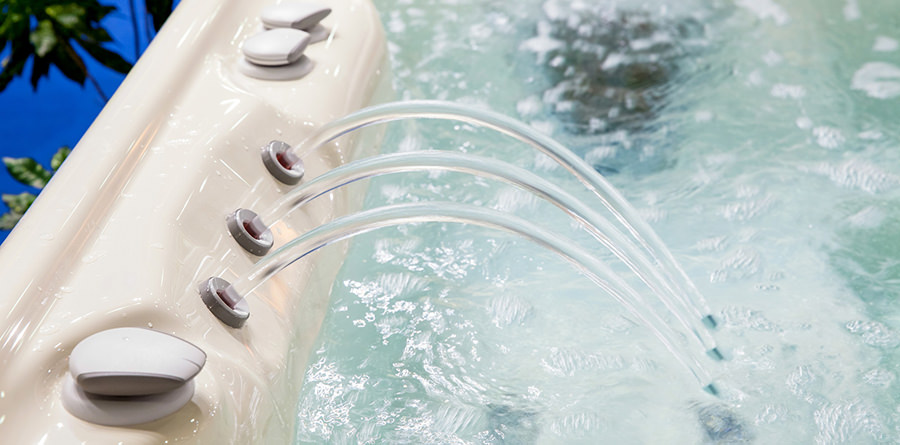
Use the minimum amount of recommended chlorine – Try to use the minimum amount of Chlorine to do the job. If your hot tub is used relatively lightly and you work hard to keep your water as clean as possible then you should easily be able to use only the minimum amount of Chlorine to keep the water sanitary and safe.
Use your hot tub in a well-ventilated area – A lot of hot tubs will be outside which means that the vapors given off by it will dissipate quickly anyway. But, if you have an indoor hot tub give very careful thought to how you will keep the room well ventilated.
Clean and change your filters at the recommended intervals – Keeping your water as clean as possible uses the least amount of Chlorine so make sure that you keep to a regular maintenance schedule and clean and replace your filters at the recommended intervals.
What are the alternatives to chlorine and bromine?
Luckily there are a number of alternatives to using Chlorine or Bromine in your hot tub and many of them are much more natural and less abrasive as well. I have written a very detailed post on ways to keep your hot tub clean naturally here. However, let’s have a brief loom at the alternatives here as well.
The first thing to say is that, despite the marketing claims, the chances are that with any of these alternative sanitization systems you will need to use some Chlorine as well. Depending upon the amount of use your hot tub gets and how clean you are able to keep it you might get away with just shock dosing the hot tub when you first fill it, or you might need to use a regular chlorine shock with it as well.
The point is though that, if you supplement your sanitization system with one of the alternatives your chlorine use will go down and that, broadly speaking is a good thing.
So what alternatives are out there?
Well, you could try a saltwater system that uses a system of electrolysis and mildly salted water to produce naturally occurring chlorine. Alternatively, there are Ozonators that use Ozone gas to kill bacteria, UV filtration systems that kill bacteria by zapping it with UV light and mineral filtration systems as well.
All of the above systems have their pros and cons and, it might be possible to use them without using any Chlorine at all but it is more likely that they will reduce your chlorine useage.
Should you use chlorine or bromine in your hot tub?
The bottom line is that Chlorine and Bromine, when used properly will completely kill all bacteria in your hot tub and keep it completely safe. People have been exposed to these chemicals for decades, they are a well known quantity and, to a certain extent, their advantages outweigh their disadvantages.
However, there are a number of health risks associated with these chemicals and there are also a number of effective alternative sanitization solutions that will greatly reduce your Chlorine or Bromine usage.
If you have a very heavily used hot tub then you may have no alternative other than to stick with a heavily Chlorinated hot tub in order to keep it clean and safe. however, if your bot tub gets only relatively light use then, to me at least, it makes sense to look into using an alternative sanitization system to use in tandem with Chlorine or Bromine and to reduce the amount that you use and are exposed to.

